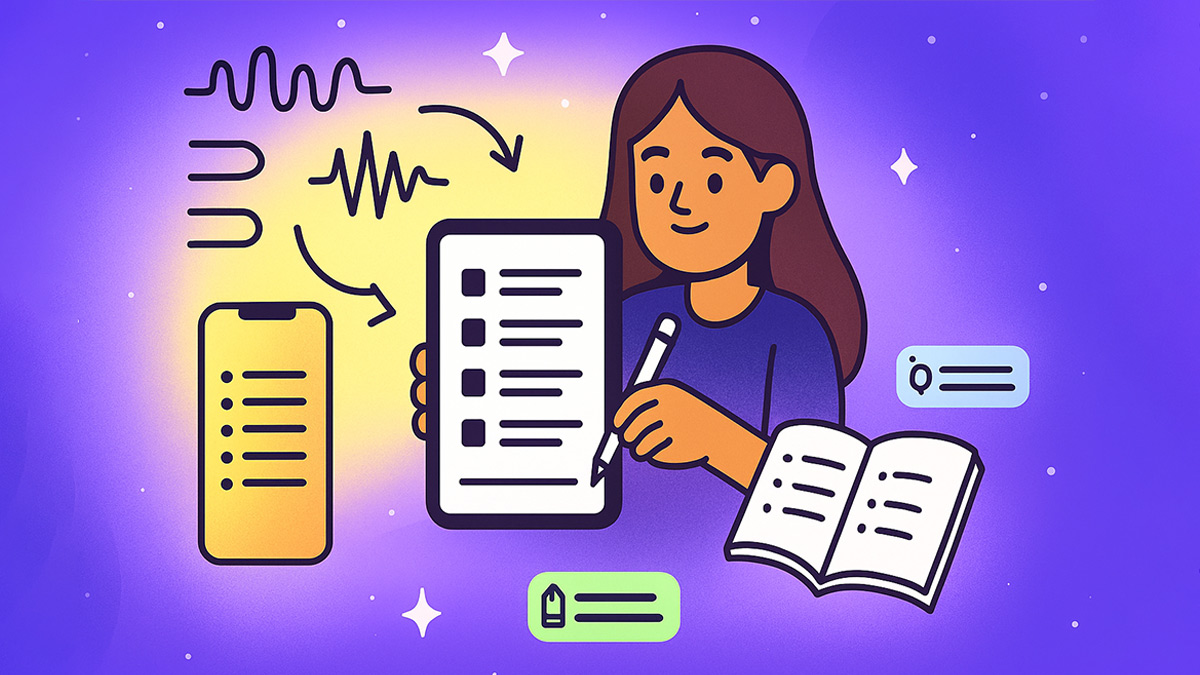APA references Gemini matter because accurate citations protect credibility, speed grading, and prevent accidental plagiarism. These prompts help students and teachers generate clean APA and MLA entries and in-text citations fast, with fewer format errors. Recent surveys show rapid academic AI adoption and demand for trustworthy sources, which supports guided citation workflows using Gemini. Elsevier Insights, 2024. For style specifics, see Purdue OWL APA and MLA Style Center.
For our full APA and MLA guide for AI notes visit: How to Cite AI Notes in APA & MLA
What Are APA/MLA Citation Prompts for Students?
These are structured instructions you paste into Gemini to produce complete APA or MLA references and exact in-text citations. They’re built for high school and college students, teachers, and researchers who want fast, error-checked bibliography entries.
Learn if AI Note Taking is allowed in your school: Is AI Note Taking Allowed in Schools?
How to Use These AI Citation Prompts
Pick 3–5 prompts, paste your source text or link, then run in Gemini. Export your references to Google Docs or CSV when done. New to AI note-taking? Read the Get Started with AI Note Taking.
APA Reference List Prompts (1–20)
Create Publication Manual-compliant APA 7th references for books, articles, web pages, videos, and datasets. These prompts also handle capitalization, DOIs, edition data, and group authors per APA rules.
- Generate a complete APA 7th reference for this journal article, including DOI if present.
- Create an APA book reference with edition, publisher, and translator when applicable.
- Format an APA web page reference with author, date, title case, site name, and URL.
- Produce an APA reference for a news article with byline, date, outlet, and URL.
- Generate an APA conference paper reference with proceedings title and page range.
- Create an APA preprint reference with repository name and persistent identifier or URL.
- Format an APA dataset reference with version, publisher, and DOI where available.
- Produce an APA report reference with corporate author, number, and publisher location if given.
- Create an APA chapter-in-edited-book reference with editors, edition, and pages.
- Format an APA YouTube video reference with channel, date, title, and URL.
- Generate an APA podcast episode reference with host, episode title, number, and URL.
- Create an APA lecture slides reference with course, institution, and repository link.
- Format an APA government webpage reference with agency as group author and date.
- Produce an APA thesis or dissertation reference with university, database, and accession number.
- Create an APA figure image reference with creator, year, title, and source URL or DOI.
- Generate an APA software reference with version, publisher, and retrieval link if needed.
- Format an APA encyclopedia entry reference with editor, edition, and page span if print.
- Create an APA newsletter article reference with issue date, section, and URL if online.
- Produce an APA image from museum collection reference with accession and location details.
- Generate an APA personal communication note for emails or interviews without retrievable sources.
APA specifics: author-date in-text, sentence-case titles, DOIs as URLs. See Purdue OWL.
APA In-Text Citation Prompts (21–40)
Generate parenthetical and narrative citations, multiple authors, missing dates, page or paragraph numbers, and repeated citations per APA 7th guidance.
- Create an APA narrative in-text citation for one author with year only.
- Create an APA parenthetical citation for two authors with ampersand and year.
- Generate an APA citation for three or more authors using first author et al.
- Produce an APA quotation citation with page number and signal phrase example.
- Generate an APA paraphrase citation without page number for general ideas.
- Create an APA citation for missing date using n.d. with author and title cue.
- Format an APA citation for corporate author with abbreviation on first mention.
- Generate an APA citation for multiple works in one parenthesis ordered alphabetically.
- Create an APA same-author different-years citation with suffix letters if needed.
- Produce an APA secondary citation indicating “as cited in” with full reference guidance.
- Generate an APA citation for personal communication noted only in text with date.
- Create an APA citation for classical works using year of translation and original year brackets.
- Format an APA citation for webpage with no author using title and year cue.
- Produce an APA citation for multiple editions of same work cited across paragraphs.
- Generate an APA block quote citation with parenthetical year and page range format.
- Create an APA citation for dataset variables referenced with table or figure numbers.
- Format an APA repeated-citation strategy for same source in one paragraph narrative.
- Generate an APA in-text for an organization with known abbreviation on subsequent mentions only.
- Create an APA citation for multiple same-year works from same author with letters assigned.
- Produce an APA legal source citation cue directing readers to reference entry details.
APA in-text overview: author–date method, pages for quotes. See Purdue OWL basics.
MLA Works Cited Prompts (41–60)
Build MLA 9th edition entries using core elements, including author, title, container, contributors, version, number, publisher, publication date, and location.
- Create an MLA works-cited entry for a journal article with volume, issue, and pages.
- Generate an MLA book entry including editor, translator, edition, and publisher when relevant.
- Format an MLA website entry with author, page title in quotes, site, date, and URL.
- Produce an MLA newspaper article entry with edition, section, and stable link when available.
- Create an MLA anthology chapter entry listing chapter author and container editors correctly.
- Generate an MLA entry for a YouTube video including channel as publisher and timestamp cue.
- Format an MLA podcast episode entry with episode title, series title, host, and URL.
- Produce an MLA thesis or dissertation entry with university, year, and repository details.
- Create an MLA image entry from a museum collection with institution and accession number.
- Generate an MLA dataset entry with version, publisher, and DOI or stable URL location.
- Format an MLA interview entry distinguishing personal interview versus published interview container.
- Produce an MLA entry for a government report with agency as author and publisher field handled.
- Create an MLA encyclopedia entry with container, edition, and page range if printed source.
- Generate an MLA software entry with version, publisher, and platform details when relevant.
- Format an MLA multi-container entry for an article in a database with DOI or permalink.
- Produce an MLA conference paper entry specifying conference name, location, date, and container.
- Create an MLA film entry with director, contributors, production company, and year release details.
- Generate an MLA entry for a chapter PDF posted online with stable URL and container cues.
- Format an MLA artwork reproduced in a book with original date and reproduction details noted.
- Produce an MLA entry for social media posts with handle, post text in quotes, platform, and URL.
MLA uses core elements and containers; see MLA Works Cited Quick Guide.
MLA In-Text Citation Prompts (61–80)
Produce concise parenthetical citations with author and page numbers, plus signal phrases, multiple sources, and corporate authors per MLA guidance.
- Create an MLA parenthetical citation with author and page number only.
- Generate an MLA narrative citation integrating author in sentence and page in parentheses.
- Format an MLA in-text for work with two authors using and in the citation.
- Generate an MLA in-text for three or more authors using first author et al.
- Produce an MLA citation for indirect source using qtd. in before the source author.
- Create an MLA citation for no page numbers using author only or timestamp for media.
- Generate an MLA multiple-citations parenthesis separated by semicolons, alphabetized by author.
- Format an MLA corporate author citation and shorten long organization names smartly.
- Produce an MLA classic work citation using division numbers instead of page numbers when needed.
- Create an MLA citation for same author multiple works using shortened titles in parentheses.
- Generate an MLA citation for anonymous works using shortened title and page number.
- Format an MLA citation for multivolume works with volume and page numbers correctly ordered.
- Produce an MLA citation for poetry lines with line numbers and forward slashes format.
- Create an MLA in-text for plays using act, scene, and line numbers separated by periods.
- Generate an MLA citation for time-stamped audiovisual sources using hours:minutes:seconds.
- Format an MLA citation when author is mentioned in text; include page only in parentheses.
- Produce an MLA citation for two sources by same author in one sentence unambiguously.
- Create an MLA citation for multiple authors with identical surnames using initials if needed.
- Generate an MLA citation for translated works acknowledging translator in prose or citation.
- Format an MLA citation for scripture using book, chapter, and verse with version abbreviated.
MLA in-text overview: author + page; see MLA in-text overview.
Edge Cases, Missing Data, and Special Sources (81–100)
Handle tricky inputs: missing authors, undated pages, broken links, uncommon media, and AI sources. Prompts include fallback patterns aligned with APA and MLA policies.
- Suggest APA and MLA fallback entries when author is unknown but publisher is known.
- Create entries for undated web pages using n.d. (APA) and access date (MLA when advised).
- Convert a broken URL into a best-available stable link, DOI, or archived copy reference.
- Draft entries for AI outputs following current APA and MLA guidance for generative AI.
- Normalize author name variants across sources to maintain consistent initials and capitalization.
- Produce entries for retracted articles including retraction notice and cross-references as needed.
- Create entries for works with both DOI and URL, selecting APA-preferred DOI as URL format.
- Generate entries for preprint and published versions while avoiding duplicate citations in text.
- Draft entries for conference posters and slides with repository or institutional URLs attached.
- Create entries for non-English works with translated titles in brackets per style rules.
- Generate entries for book chapters with DOIs, including chapter numbers and editors correctly.
- Produce entries for encyclopedia articles without authors using organization as author when applicable.
- Create entries for legal sources referencing statutes or cases with correct container details.
- Generate entries for standards or technical specifications with publisher numbers and versions.
- Draft entries for course handouts or LMS files specifying instructor, course, and institution context.
- Create entries for images generated by AI, clarifying creator, model, and prompt metadata notes.
- Produce entries for datasets with restricted access, indicating access statement appropriately.
- Generate entries for software code repositories with commit hashes and release tags recorded.
- Create entries for images embedded in articles distinguishing original source versus reproduction credit.
- Draft entries for archived web pages using archive date and stable snapshot location details.
MLA guidance evolves for AI sources; see MLA on citing generative AI.
Quality Checks, Examples, and Exports (101–120)
Validate capitalization, punctuation, and ordering. Generate side-by-side APA/MLA examples, then export clean lists to paste into your paper.
- Validate APA capitalization rules for article titles and sentence-case corrections automatically.
- Validate MLA title-style capitalization and italics for containers and works correctly applied.
- Check all DOIs resolve and replace dead links with current DOI URLs when available.
- Confirm alphabetical ordering rules for APA references and MLA works cited list items.
- Verify punctuation placement for parentheses, periods, and commas in all entries precisely.
- Produce paired APA and MLA examples for each source type with labeled differences highlighted.
- Generate a final APA reference list sorted correctly and formatted with hanging indents only.
- Generate a final MLA works cited page with double spacing and hanging indents applied.
- Create a side-by-side APA versus MLA cheat sheet for my specific sources list.
- Produce example in-text citations for every entry and align them with references consistently.
- Export all APA references to CSV with columns: Author, Year, Title, Source, DOI/URL.
- Export all MLA entries to CSV with columns per core elements in correct order.
- Flag possible duplicates across sources using title and DOI similarity thresholds clearly explained.
- Check capitalization for proper nouns inside titles and fix APA or MLA mismatches accordingly.
- Validate publisher fields to avoid repeating organization as both author and publisher when disallowed.
- Standardize date formats to APA year-only or MLA day Month Year as appropriate per entry.
- Generate a references audit explaining each formatting decision with citations to style pages.
- Create a one-page APA example list from these sources suitable for appendix inclusion.
- Create a one-page MLA example page from these sources with perfect hanging indents.
- Produce final submission-ready APA and MLA versions and list unresolved edge cases separately.
Printable & Offline Options
Print this page or save a PDF to use offline. Teachers can paste selected prompts into handouts or LMS pages. See more student prompt hubs at /students/prompts.
Related Categories
- Research & Citations Prompts
- Academic Writing Prompts
- Study Guide Prompts
- Explain Concepts Prompts
- AI Study-Guide Generator
FAQ
How accurate are Gemini’s APA and MLA outputs?
Accuracy is high when you supply complete source metadata and verify against trusted style resources. Cross-check unusual cases with Purdue OWL APA and the MLA Style Center.
Should I prefer DOIs or URLs in APA?
Use the DOI formatted as a URL when available; otherwise include the stable URL. See APA reference rules on DOIs and URLs via Purdue OWL.
When do I add access dates in MLA?
Add access dates when the source is likely to change or no publication date is given. MLA emphasizes core elements and stability; see the Works Cited quick guide.
Can I cite generative AI itself?
Yes, but follow current style guidance and your instructor’s policy. MLA offers specific advice for citing generative AI outputs; check MLA guidance.
Is AI use acceptable in class?
Policies vary. Many students already use AI for academic tasks, so confirm your syllabus rules. See adoption data in Elsevier 2024 and sector reports.
How accurate are Gemini’s APA and MLA outputs?
Accuracy depends on complete metadata and verification against official style resources like Purdue OWL and the MLA Style Center.
Should I prefer DOIs or URLs in APA?
Prefer DOI-as-URL when available; otherwise provide a stable URL per APA 7th.
When do I add access dates in MLA?
Include access dates for undated or frequently changing web content per MLA guidance.
Can I cite generative AI itself?
Yes, follow current MLA/APA instructions and course policy. Document model, date, and context when required.
Is AI use acceptable in class?
Check your syllabus or instructor. Adoption is widespread but policies differ by course and institution.
Final Thoughts
These 120 prompts turn messy source details into clean APA and MLA citations, complete with matching in-text examples and exportable lists. Want more? Start AI note taking instantly for free with our AI note taker.
References for style verification: Purdue OWL, APA In-Text; MLA Style Center, Works Cited Quick Guide; Elsevier Insights, 2024.



